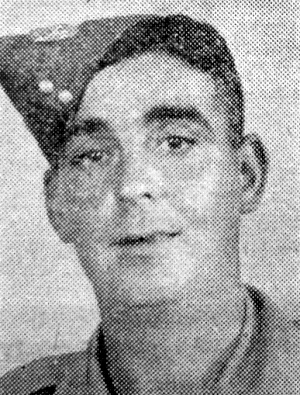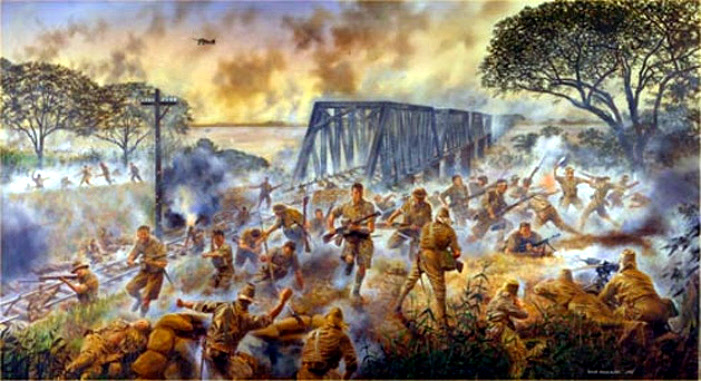
Albert Kilburn was born in Horbury in late 1915, the third son, and fifth child of eight children, born to John Gaffney Kilburn and his wife Bertha (nee Dalton), both of Spring End, Horbury, who were married at St Peter’s & St Leonard’s Church Horbury on 15th September 1906. John, a miner, was 32 years of age and Bertha was aged 21 years.
In 1911, John Gaffney Kilburn was living at 13, Elba Terrace, Spring End, Horbury with his Dublin born mother, Ann, a 72 year old widow. John’s wife, Bertha, was living at Ackworth with their two surviving children, born before 1911; Alice (born 1907) and John (born 1910) and also Maggie Dalton (born 1905) from an earlier relationship.
The couple had also lost a daughter, Kathleen, who was born in Spring 1909, and sadly died later the same year. The couple later had children: George, born 1913; Albert, born 1915; Nathan, born 1920; Ann, born 1918 and Sarah, born 1923.
By September 1939, John G., his wife Bertha, and their daughter, Ann, were living at 62, Teall Street, Ossett. By this time, John G. was 65 years of age and a dataller (day worker or a worker on a zero hours contract) in a coal mine, while his daughter, Ann, worked as cloth weaver in a local mill. Two of Albert’s brothers also served during WW2: George, born in the Hemsworth area in 1913, and Nathan B., born in Horbury in 1920. Their father John G. Kilburn died in Ossett in the summer of 1943, aged 69 years.
On the 7th October 1949, John’s widow, Bertha, aged 64 years, of 62, Teall Street, Ossett, boarded the P&O ship, ‘Georgic’, at Liverpool and sailed for Sydney, Australia. She was accompanied by her eldest son, the eponymous, John Gaffney Kilburn, an engineer, of Hednesford, Staffordshire, with his wife, Nellie and their two children John G (born 1942) and Michael A. Kilburn who was born in 1944. The family appear to have settled at Bass Hills, New South Wales, Australia. John Gaffney Kilburn junior, born in Horbury in 1910, died on 19th December 1983 and is buried at St Mary Magdalene Anglican Churchyard, Penrith City, New South Wales, Australia. Penrith city is barely 20 miles from Bass Hills.
The “Ossett Observer” had this obituary for Albert Kilburn:1
“Further Local Casualties – Sergeant Albert Kilburn, Ossett – The deepest sympathy is extended to Mrs. Bertha Kilburn, widow, of 62, Teall Street, Ossett, who, after nearly four years of anxiety, received a letter from the War Office on Thursday, that her son Sergeant Albert Kilburn (29), K.O.Y.L.I., had been killed in Burma.
The letter regrets ‘that, as a result of inquiries, further information has been received which the department has no alternative but to accept as reliable evidence, that Sergeant Kilburn was mortally wounded during the fighting at the Sittang River, Burma, in February 1942. It is consequently being officially recorded that he was killed in action in Burma on February 23rd, 1942. The letter also conveys the sincere sympathy of the department with the bereaved.‘
Sergeant Albert Kilburn was one of three sons serving in the forces of Mr. and Mrs. John Kilburn, 62, Teall Street, and formerly Spring End. Albert was educated at St. Peter’s School, Horbury, and afterwards worked for Wagon Repairs Ltd. at Horbury Bridge. He joined the Army in October 1933, and after twelve months in Gibraltar, went to India, moving to Burma in 1935. He was stationed in Rangoon during the riots of about eight years ago, and served in the Burma campaign in the earlier years of the present war. He played a good deal of rugby football for his regiment in Burma and was also a keen boxer and water polo exponent.”
The 2nd Battalion, K.O.Y.L.I. remained in Burma until the outbreak of the war against Japan in December 1941. When the Japanese invaded Burma, the 2nd Battalion formed part of the pitifully small and ill-equipped force which tried to hold them up; it was the first British Battalion to engage the Japanese in Burma. During the retreat from Moulmein to Rangoon, the Battalion lost heavily in a number of engagements, particularly at the Battles of Bilin and Sittang. In February 1942, the regular soldiers of the 2nd Battalion, K.O.Y.L.I. were attached to the 16th Indian Infantry Brigade as part of the 17th Indian Division in the failed defence of Burma against the invading Japanese.
On February 23rd, 1942, it had been 75 days since Pearl Harbor, and the Japanese had not showed any signs of slowing down. They had successfully invaded Singapore and Malaysia, made their way through Thailand and into Southeast Burma. Still 50 days away from America’s first offensive action on Japan (The Doolittle Raid), the British had found themselves in a desperate situation. Stop the Japanese from taking Burma (a British colony at the time), and protect arguably the most important British colony, India.
After losing battles at the Burma/Thai border, the British/Indian Army found themselves quickly retreating westwards towards the Sittang River. There they had to cross a narrow rail bridge that could barely handle one-way traffic. This bridge, the Sittang Bridge was the last major obstacle between the Japanese Army and its objective of occupying Rangoon. If the British lost this bridge, not only would Japan have an easy march on Rangoon, but the British would also be cut off from China and forced to retreat into India, leaving Burma in the hands of Japan.
The British set up defences on the east bank of the river and nearby hill to prepare for the Japanese attack. The bridge was also rigged with dynamite so that they could blow the bridge in the event that the Japanese broke through the defense lines. They could not risk the Japanese capturing the bridge intact. The river, spanned by the railway bridge, was fast-flowing and nearly 1000 yards wide.
The main stronghold on the east side of the river was on the high ground known as Pagoda Hill. Starting at about 1 a.m. on February 22nd, the hill and its surrounding area saw a complete 24-hour span of brutal hand-to-hand fighting.

Above: David Rowland’s painting of the Battle of Sittang Bridge. The painting depicts the fighting on the river’s east bank as viewed from Pagoda Hill.
At 5 a.m., nearly 30 hours of continuos fighting had caused complete confusion on the the west side of the river bank. The British Commander, John Smyth, was unaware that the Indian Army was still successfully holding the Japanese from taking Pagoda Hill, and assumed that the majority of the army had made a successful retreat to the west bank. At 5:30 am, in fear of the Japanese taking the bridge, Smyth made the call to blow the bridge, stranding more than 6,000 soldiers on the other side.
After five minutes of complete silence, chaos began again. The rest of the day consisted of Indian troops trying to find a way to cross the mile-wide river any way they could while a select group of heroic troops continued to fight off the Japanese. The stranded troops who knew how to swim got across, but had a difficult time finding boats because most had been destroyed before the battle. Many built make-shift rafts and other floatation devices to help get across. The 30+ hour battle had left hundreds of wounded men on the wrong side of the bridge, and the British were lucky that the Japanese chose not to completely annihilate the remaining soldiers. The Japanese were more interested in crossing the river, than slaughtering the remaining troops and began moving north to find a narrower place to ferry across.
The battle was a decisive Japanese victory, and it marked the beginning of the Japanese occupation of Burma. The British/Indian Army in Burma was left in disarray, and had lost a considerable amount of supplies on the other side of the bridge. They retreated all the way into India, where they would remain until finally being able to re-enter Burma for a counter-offensive campaign with the Americans and Chinese. Burma would finally be secured and liberated from the Japanese in July of 1945, when ironically the British finished off the Japanese back where it all started, at the Sittang River.
Albert Kilburn died on the 23rd February 1942, aged 26 years, and is remembered on Face 16 of the Rangoon (Yangon) Memorial, Burma (now Myanmar). Taukkyan War Cemetery is in Taukkyan town in the township of Mingaladon, Yangon greater area. The Rangoon Memorial bears the names of almost 27,000 men of the Commonwealth land forces who died during the WW2 campaigns in Burma (now Myanmar) and who have no known grave.2

Above:The Sittang Battlefield as it looks today. The pillars from the original bridge are still standing. The land along the river was the scene of immense suffering of the wounded who were unable to swim across to safety.3
References:
1. “Ossett Observer”, December 22nd 1945.
2. Commonwealth War Graves Commission web site
3. This World Rocks – Uncovering Burma’s WW2 Past – Part One: The account of the Battle of Sittong River, that cost Sergeant Albert Kilburn his life, and the pictures of the bridge and the David Rowlands painting are from this very informative web site.